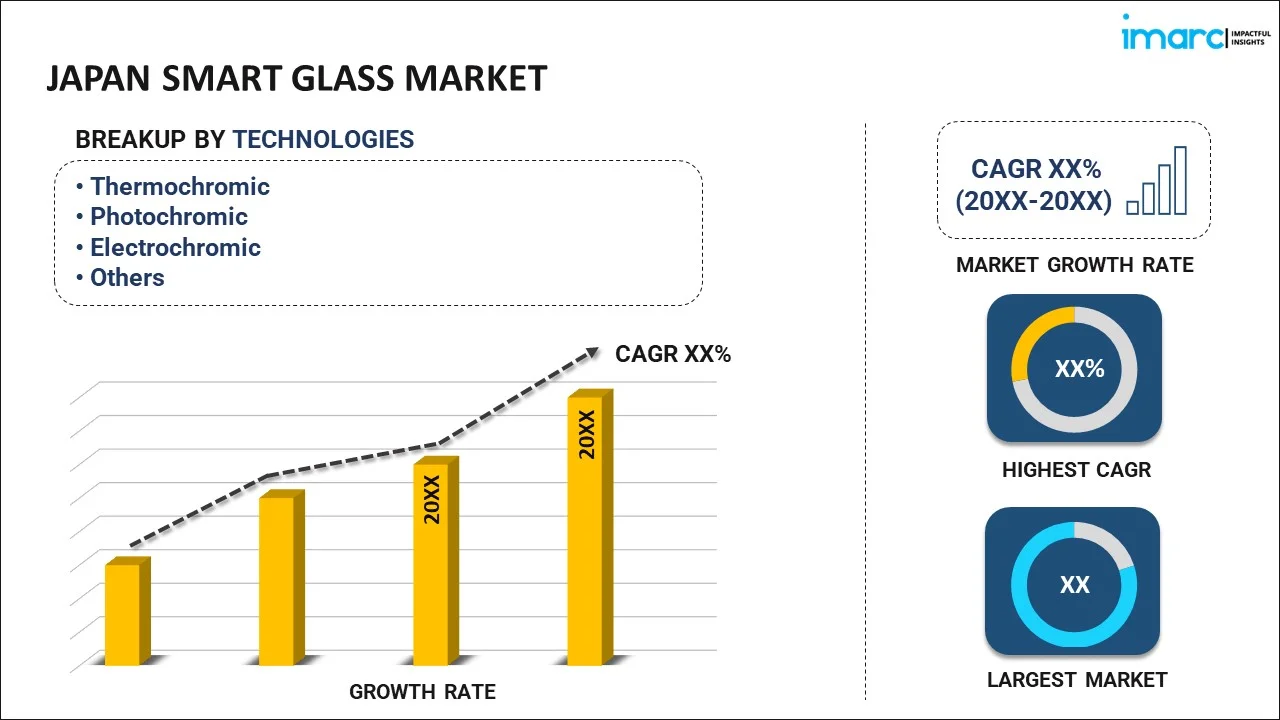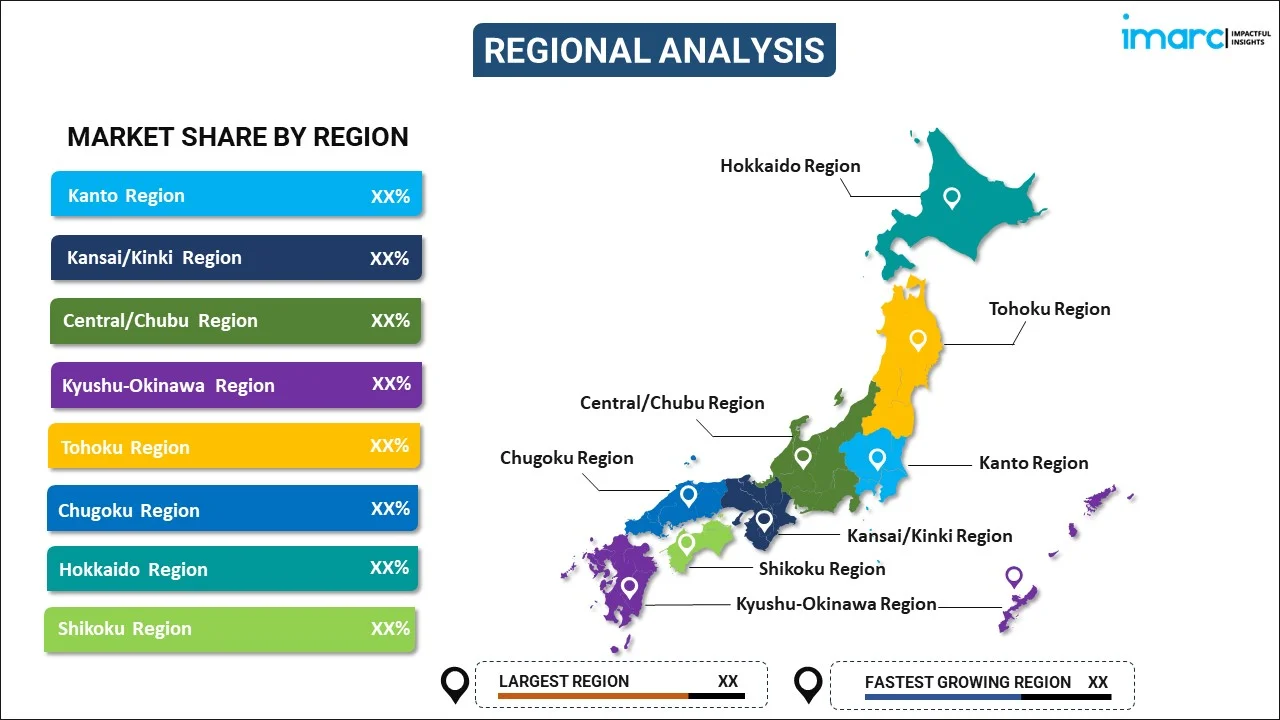
Japan Smart Glass Market Report by Technology (Thermochromic, Photochromic, Electrochromic, Suspended Particle Device (SPD), Polymer Disperse Liquid Crystal (PDLC), and Others), Control Mode (Dimmers, Switches, Remote Control, and Others), Application (Architectural, Transportation, Consumer Electronics, Power Generation), and Region 2025-2033
Market Overview:
Japan smart glass market size reached USD 408.0 Million in 2024. Looking forward, IMARC Group expects the market to reach USD 1,257.0 Million by 2033, exhibiting a growth rate (CAGR) of 13.3% during 2025-2033. The growing emphasis on sustainability and green building practices that has led to increased interest in smart glass as a way to reduce a building's environmental footprint by optimizing natural light and temperature control, is primarily driving the market.
|
Report Attribute
|
Key Statistics
|
|---|---|
|
Base Year
|
2024
|
|
Forecast Years
|
2025-2033
|
|
Historical Years
|
2019-2024
|
|
Market Size in 2024
|
USD 408.0 Million |
|
Market Forecast in 2033
|
USD 1,257.0 Million |
| Market Growth Rate 2025-2033 | 13.3% |
Smart glass, also called switchable glass or dynamic glass, is an innovative technology that can change its transparency or opacity in response to external stimuli, typically electricity, heat, or light. This remarkable material has a wide range of applications across various industries. In its transparent state, smart glass allows for clear visibility, much like conventional glass windows. However, when an electrical current, voltage, or specific triggers are applied, it can transition to an opaque or frosted state, providing privacy, glare reduction, and heat insulation. This transformation is reversible, enabling users to control the glass's state based on their needs. Smart glass finds applications in architecture, where it can enhance energy efficiency by regulating heat and light, reducing the need for artificial cooling or heating. It's also used in the automotive and aviation industries for sunroof and window systems, ensuring passenger comfort and privacy. Additionally, smart glass is employed in retail displays, healthcare facilities, and high-tech gadgets, offering versatility and futuristic design possibilities.
Japan Smart Glass Market Trends:
The smart glass market in Japan is experiencing rapid growth due to a confluence of key drivers. Firstly, the increasing demand for energy-efficient solutions has propelled the adoption of smart glass in both residential and commercial sectors. Additionally, the rising emphasis on sustainability and green building practices has driven the need for smart glass as it enhances energy conservation and reduces carbon emissions. Furthermore, the growing awareness of the importance of daylight utilization in buildings has boosted the smart glass market. Architects and builders are increasingly incorporating smart glass technologies to optimize natural light, thereby reducing the reliance on artificial lighting and lowering energy consumption. Moreover, the advent of smart cities and the integration of smart glass in various urban infrastructure projects have provided a significant impetus to the market. Smart glass is being deployed in public transportation systems, such as smart bus stops and train stations, to enhance passenger comfort and information dissemination. Lastly, the increasing adoption of smart glass in automotive applications, including heads-up displays and sunroofs, is expected to drive the market in Japan during the forecast period.
Japan Smart Glass Market Segmentation:
IMARC Group provides an analysis of the key trends in each segment of the market, along with forecasts at the country level for 2025-2033. Our report has categorized the market based on technology, control mode, and application.
Technology Insights:

- Thermochromic
- Photochromic
- Electrochromic
- Suspended Particle Device (SPD)
- Polymer Disperse Liquid Crystal (PDLC)
- Others
The report has provided a detailed breakup and analysis of the market based on the technology. This includes thermochromic, photochromic, electrochromic, suspended particle device (SPD), polymer disperse liquid crystal (PDLC), and others.
Control Mode Insights:
- Dimmers
- Switches
- Remote Control
- Others
A detailed breakup and analysis of the market based on the control mode have also been provided in the report. This includes dimmers, switches, remote control, and others.
Application Insights:
- Architectural
- Transportation
- Consumer Electronics
- Power Generation
The report has provided a detailed breakup and analysis of the market based on the application. This includes architectural, transportation, consumer electronics, and power generation.
Regional Insights:

- Kanto Region
- Kansai/Kinki Region
- Central/ Chubu Region
- Kyushu-Okinawa Region
- Tohoku Region
- Chugoku Region
- Hokkaido Region
- Shikoku Region
The report has also provided a comprehensive analysis of all the major regional markets, which include Kanto Region, Kansai/Kinki Region, Central/ Chubu Region, Kyushu-Okinawa Region, Tohoku Region, Chugoku Region, Hokkaido Region, and Shikoku Region.
Competitive Landscape:
The market research report has also provided a comprehensive analysis of the competitive landscape in the market. Competitive analysis such as market structure, key player positioning, top winning strategies, competitive dashboard, and company evaluation quadrant has been covered in the report. Also, detailed profiles of all major companies have been provided. Some of the key players include:
- AGC Inc.
- Gauzy Ltd.
- Gentex Corporation
(Please note that this is only a partial list of the key players, and the complete list is provided in the report.)
Japan Smart Glass Market Report Coverage:
| Report Features | Details |
|---|---|
| Base Year of the Analysis | 2024 |
| Historical Period | 2019-2024 |
| Forecast Period | 2025-2033 |
| Units | Million USD |
| Scope of the Report | Exploration of Historical and Forecast Trends, Industry Catalysts and Challenges, Segment-Wise Historical and Predictive Market Assessment:
|
| Technologies Covered | Thermochromic, Photochromic, Electrochromic, Suspended Particle Device (SPD), Polymer Disperse Liquid Crystal (PDLC), Others |
| Control Modes Covered | Dimmers, Switches, Remote Control, Others |
| Applications Covered | Architectural, Transportation, Consumer Electronics, Power Generation |
| Regions Covered | Kanto Region, Kansai/Kinki Region, Central/ Chubu Region, Kyushu-Okinawa Region, Tohoku Region, Chugoku Region, Hokkaido Region, Shikoku Region |
| Companies Covered | AGC Inc., Gauzy Ltd., Gentex Corporation, etc. |
| Customization Scope | 10% Free Customization |
| Post-Sale Analyst Support | 10-12 Weeks |
| Delivery Format | PDF and Excel through Email (We can also provide the editable version of the report in PPT/Word format on special request) |
Key Questions Answered in This Report:
- How has the Japan smart glass market performed so far and how will it perform in the coming years?
- What has been the impact of COVID-19 on the Japan smart glass market?
- What is the breakup of the Japan smart glass market on the basis of technology?
- What is the breakup of the Japan smart glass market on the basis of control mode?
- What is the breakup of the Japan smart glass market on the basis of application?
- What are the various stages in the value chain of the Japan smart glass market?
- What are the key driving factors and challenges in the Japan smart glass?
- What is the structure of the Japan smart glass market and who are the key players?
- What is the degree of competition in the Japan smart glass market?
Key Benefits for Stakeholders:
- IMARC’s industry report offers a comprehensive quantitative analysis of various market segments, historical and current market trends, market forecasts, and dynamics of the Japan smart glass market from 2019-2033.
- The research report provides the latest information on the market drivers, challenges, and opportunities in the Japan smart glass market.
- Porter's five forces analysis assist stakeholders in assessing the impact of new entrants, competitive rivalry, supplier power, buyer power, and the threat of substitution. It helps stakeholders to analyze the level of competition within the Japan smart glass industry and its attractiveness.
- Competitive landscape allows stakeholders to understand their competitive environment and provides an insight into the current positions of key players in the market.
Need more help?
- Speak to our experienced analysts for insights on the current market scenarios.
- Include additional segments and countries to customize the report as per your requirement.
- Gain an unparalleled competitive advantage in your domain by understanding how to utilize the report and positively impacting your operations and revenue.
- For further assistance, please connect with our analysts.
 Inquire Before Buying
Inquire Before Buying
 Speak to an Analyst
Speak to an Analyst
 Request Brochure
Request Brochure
 Request Customization
Request Customization




.webp)




.webp)












